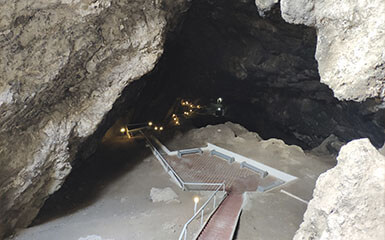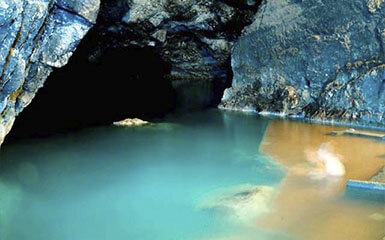Ashgabat
Alem Ferris wheel
State Museum
Fine Arts museum
Wedding Palace
Nisa fortress
Memorial Complex
Ertogrul Gazi Mosque
Neutrality monument
Independence Park
Turkmenbashi Ruhy Mosque
Olympic Village
Ylham Alley
Carpet Museum
Monument of Lenin
Ahal Region
Abivert
Altyn Depe
Annau
Darvaza
Geokdepe
Kowata
Mane baba
Zengi baba
Nedir Shah
Nokhur
Parzdepe
Sarahs baba
Seyit Jemaleddin mosque
Shahrislam
Ulug depe
Mary region
40 cupolas
Akcha Kala
Ancient Merv
Badkhyz
Chilburj
Gebeklytepe
Geok Gumbaz
Gurtly Depe
Kharoba Koshuk
Talkhatan Baba
Yekedeshik
Dashoguz region
Ashyk Aydyn Pir
Devkeshen
Ismamit ata
Kalaly-gyr
Kaplankyr Nature Reserve
Kunya-Urgench
Damla
Balkan region
Dehistan
Yangikala
Awaza
Gozli ata
Kemal ata
Mashat ata
Paraw bibi
Lunar Mountains
Shevlan Baba
Igdy kala
Kowata underground lake - the father of caves

Welcome to the sulphurous subterranean world of Kowata underground lake. Here is the place that you could never come across elsewhere in Central Asia. It is a brilliant opportunity to rest for a while on the way to the Balkanabat from the Ashgabat. The cave is only 60 km far from Ashgabat.
The lake is 65 meter inside of the well-known Bakharden cave. Its fame is connected rather with the healing properties of water, than the beauty of this underground nature. The therapeutic water of the Kowata underground lake includes 38 elements such as iodine, magnesium, iron, bromine, potassium, sodium, sulphate, and others. The lake depth varies from 8 to 14m. Swimming in Kowata underground lake is highly recommended for stricken people to improve blood circulation, help control rheumatism, skin disorder and kidney diseases, and ease the nervous system. The water is naturally heated to about 36°C and recommended swimming time is nearly 20 minutes due to the sulphur.
Entrance fee is required. You enter a cave at the base of a mountain and walk down a staircase, 65m underground, which takes you into a wonderful experience. Staircase is quite slippery because of moisture. There are some platforms to change clothes and leave your stuff. However, it is recommended to leave your stuff outside if it is possible because of sulphurous smell.


There are several facilities to have kebab (shashlyk) for lunch next to the cave. It would be excellent decision to perk up. Weekends can be crowded there (especially on Sunday) that’s why weekdays will be more relaxing and silent.
The history of the cave is quite impressive because it was used to heal mortally wounded rebellious slaves during the Parthian Empire. Besides, the cave is located in a seismic region but it is save from earthquakes. Over the past 100 years these places experienced more than 200 earthquakes of different intensity, but the cave remains stable.
Kowata underground lake serves people since ancient times without losing its property. If there is a suffer, there is a remedy. The Lake is living proof for this statement.